17. Spring Boot 配置嵌入式Servlet容器
一、如何定制和修改Servlet容器的相关配置
1、配置文件(ServerProperties);
优先级最高
server.port=8081
server.context‐path=/crud
server.tomcat.uri‐encoding=UTF‐8
//通用的Servlet容器设置
server.xxx
//Tomcat的设置
server.tomcat.xxx
2、java代码
2.1 Spring Boot 1.5.10 版本
@Bean //一定要将这个定制器加入到容器中 嵌入式的Servlet容器定制器
public EmbeddedServletContainerCustomizer embeddedServletContainerCustomizer(){
return new EmbeddedServletContainerCustomizer() {
//定制嵌入式的Servlet容器相关的规则
@Override
public void customize(ConfigurableEmbeddedServletContainer container) {
container.setPort(8083);
}
};
}
2.2 Spring Boot 2.1.0版本
2.2.1、 方式1 (优先级第二)
import org.springframework.boot.web.server.WebServerFactoryCustomizer;
import org.springframework.boot.web.servlet.server.ConfigurableServletWebServerFactory;
import org.springframework.stereotype.Component;
@Component
public class CustomizationBean implements WebServerFactoryCustomizer<ConfigurableServletWebServerFactory> {
@Override
public void customize(ConfigurableServletWebServerFactory server) {
server.setPort(9000);
}
}
2.2.2、方式2 (优先级最低)
@Bean
public ConfigurableServletWebServerFactory webServerFactory() {
TomcatServletWebServerFactory factory = new TomcatServletWebServerFactory();
factory.setPort(9000);
// factory.setSessionTimeout(10, TimeUnit.MINUTES); 此方法没找到
factory.addErrorPages(new ErrorPage(HttpStatus.NOT_FOUND, "/notfound.html"));
return factory;
}
二、自定义Servlet容器
1、Spring Boot 支持的 Servlet容器类型

2、切换Tomcat容器为jetty容器
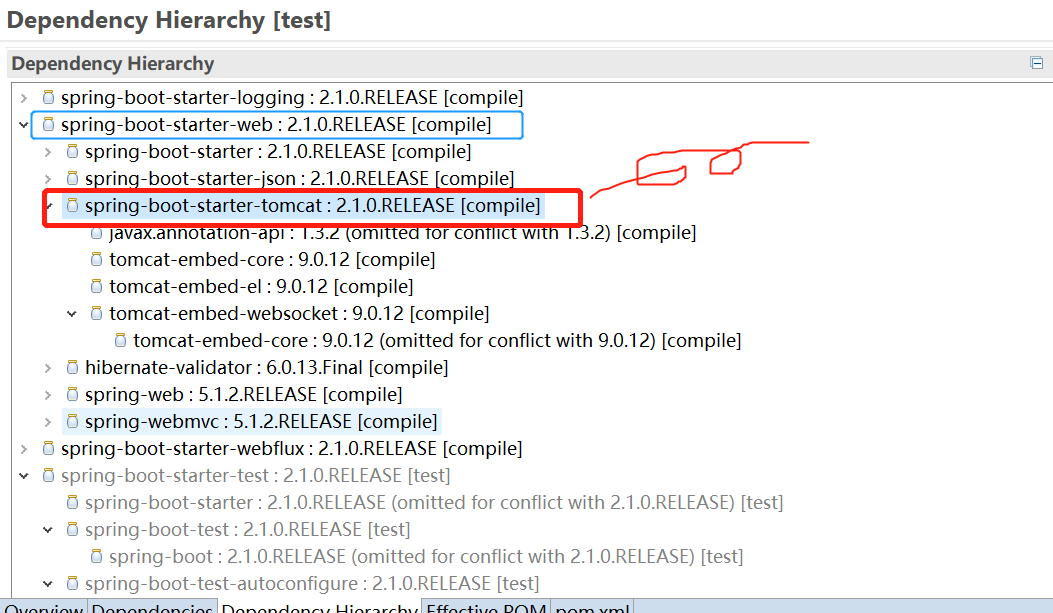
<dependency>
<groupId>org.springframework.boot</groupId>
<artifactId>spring-boot-starter-web</artifactId>
<exclusions><!-- 排除掉默认的Tomcat web容器-->
<exclusion>
<groupId>org.springframework.boot</groupId>
<artifactId>spring-boot-starter-tomcat</artifactId>
</exclusion>
</exclusions>
</dependency>
<!-- 引入jetty容器。jetty 适合长连接的场景-->
<dependency>
<groupId>org.springframework.boot</groupId>
<artifactId>spring-boot-starter-jetty</artifactId><!-- spring-boot-starter-undertow ,不支持JSP-->
</dependency>
undertow
包下:spring-boot-autoconfigure-2.1.0.RELEASE.jar

三、嵌入式Servlet容器自动配置原理Spring Boot 2.1.0版本示例: (注:1.5.10 和2.1.0版本有很大不同)
Servelt容器的自动配置类
@Configuration
@ConditionalOnWebApplication
@EnableConfigurationProperties(ServerProperties.class)
public class EmbeddedWebServerFactoryCustomizerAutoConfiguration { /**
* Nested configuration if Tomcat is being used.
*/
@Configuration
@ConditionalOnClass({ Tomcat.class, UpgradeProtocol.class })
public static class TomcatWebServerFactoryCustomizerConfiguration { @Bean
public TomcatWebServerFactoryCustomizer tomcatWebServerFactoryCustomizer(
Environment environment, ServerProperties serverProperties) {
return new TomcatWebServerFactoryCustomizer(environment, serverProperties);
} } /**
* Nested configuration if Jetty is being used.
*/
@Configuration
@ConditionalOnClass({ Server.class, Loader.class, WebAppContext.class })
public static class JettyWebServerFactoryCustomizerConfiguration { @Bean
public JettyWebServerFactoryCustomizer jettyWebServerFactoryCustomizer(
Environment environment, ServerProperties serverProperties) {
return new JettyWebServerFactoryCustomizer(environment, serverProperties);
} } /**
* Nested configuration if Undertow is being used.
*/
@Configuration
@ConditionalOnClass({ Undertow.class, SslClientAuthMode.class })
public static class UndertowWebServerFactoryCustomizerConfiguration { @Bean
public UndertowWebServerFactoryCustomizer undertowWebServerFactoryCustomizer(
Environment environment, ServerProperties serverProperties) {
return new UndertowWebServerFactoryCustomizer(environment, serverProperties);
} } /**
* Nested configuration if Netty is being used.
*/
@Configuration
@ConditionalOnClass(HttpServer.class)
public static class NettyWebServerFactoryCustomizerConfiguration { @Bean
public NettyWebServerFactoryCustomizer nettyWebServerFactoryCustomizer(
Environment environment, ServerProperties serverProperties) {
return new NettyWebServerFactoryCustomizer(environment, serverProperties);
} } }
Tomcat 的Server的定制(Jetty、Netty、Undertow 类似)
public class TomcatWebServerFactoryCustomizer implements
WebServerFactoryCustomizer<ConfigurableTomcatWebServerFactory>, Ordered { private final Environment environment; private final ServerProperties serverProperties; public TomcatWebServerFactoryCustomizer(Environment environment,
ServerProperties serverProperties) {
this.environment = environment;
this.serverProperties = serverProperties;
} @Override
public int getOrder() {
return ;
} @Override
public void customize(ConfigurableTomcatWebServerFactory factory) {
ServerProperties properties = this.serverProperties;
ServerProperties.Tomcat tomcatProperties = properties.getTomcat();
PropertyMapper propertyMapper = PropertyMapper.get();
propertyMapper.from(tomcatProperties::getBasedir).whenNonNull()
.to(factory::setBaseDirectory);
propertyMapper.from(tomcatProperties::getBackgroundProcessorDelay).whenNonNull()
.as(Duration::getSeconds).as(Long::intValue)
.to(factory::setBackgroundProcessorDelay);
customizeRemoteIpValve(factory);
propertyMapper.from(tomcatProperties::getMaxThreads).when(this::isPositive)
.to((maxThreads) -> customizeMaxThreads(factory,
tomcatProperties.getMaxThreads()));
propertyMapper.from(tomcatProperties::getMinSpareThreads).when(this::isPositive)
.to((minSpareThreads) -> customizeMinThreads(factory, minSpareThreads));
propertyMapper.from(this::determineMaxHttpHeaderSize).whenNonNull()
.asInt(DataSize::toBytes).when(this::isPositive)
.to((maxHttpHeaderSize) -> customizeMaxHttpHeaderSize(factory,
maxHttpHeaderSize));
propertyMapper.from(tomcatProperties::getMaxSwallowSize).whenNonNull()
.asInt(DataSize::toBytes)
.to((maxSwallowSize) -> customizeMaxSwallowSize(factory, maxSwallowSize));
propertyMapper.from(tomcatProperties::getMaxHttpPostSize).asInt(DataSize::toBytes)
.when((maxHttpPostSize) -> maxHttpPostSize != )
.to((maxHttpPostSize) -> customizeMaxHttpPostSize(factory,
maxHttpPostSize));
propertyMapper.from(tomcatProperties::getAccesslog)
.when(ServerProperties.Tomcat.Accesslog::isEnabled)
.to((enabled) -> customizeAccessLog(factory));
propertyMapper.from(tomcatProperties::getUriEncoding).whenNonNull()
.to(factory::setUriEncoding);
propertyMapper.from(properties::getConnectionTimeout).whenNonNull()
.to((connectionTimeout) -> customizeConnectionTimeout(factory,
connectionTimeout));
propertyMapper.from(tomcatProperties::getMaxConnections).when(this::isPositive)
.to((maxConnections) -> customizeMaxConnections(factory, maxConnections));
propertyMapper.from(tomcatProperties::getAcceptCount).when(this::isPositive)
.to((acceptCount) -> customizeAcceptCount(factory, acceptCount));
customizeStaticResources(factory);
customizeErrorReportValve(properties.getError(), factory);
}
。。。。。。
}
Spring Boot 2.1.0 版本的web容器启动流程 (Spring boot 1.5.10版本类似但不同)
1.Spring boot启动器
@SpringBootApplication
public class SpringBootDemo01Application { public static void main(String[] args) {
SpringApplication.run(SpringBootDemo01Application.class, args);
}
}
2.run方法启动过程源码分析
public class SpringApplication {
//在createApplicationContext()中根据类型classforName()加载 不同类型的
public static final String DEFAULT_CONTEXT_CLASS = "org.springframework.context."
+ "annotation.AnnotationConfigApplicationContext";
public static final String DEFAULT_SERVLET_WEB_CONTEXT_CLASS = "org.springframework.boot."
+ "web.servlet.context.AnnotationConfigServletWebServerApplicationContext";
public static final String DEFAULT_REACTIVE_WEB_CONTEXT_CLASS = "org.springframework."
+ "boot.web.reactive.context.AnnotationConfigReactiveWebServerApplicationContext";
//run1调用run2
public static ConfigurableApplicationContext run(Class<?> primarySource,String... args) {
return run(new Class<?>[] { primarySource }, args);
}
//run2调用run3
public static ConfigurableApplicationContext run(Class<?>[] primarySources,String[] args) {
return new SpringApplication(primarySources).run(args);
}
//run3启动Web服务器
public ConfigurableApplicationContext run(String... args) {
StopWatch stopWatch = new StopWatch();
stopWatch.start();
ConfigurableApplicationContext context = null;
Collection<SpringBootExceptionReporter> exceptionReporters = new ArrayList<>();
configureHeadlessProperty();
SpringApplicationRunListeners listeners = getRunListeners(args);
listeners.starting();
try {
ApplicationArguments applicationArguments = new DefaultApplicationArguments(
args);
ConfigurableEnvironment environment = prepareEnvironment(listeners,
applicationArguments);
configureIgnoreBeanInfo(environment);
Banner printedBanner = printBanner(environment);
context = createApplicationContext();
exceptionReporters = getSpringFactoriesInstances(
SpringBootExceptionReporter.class,
new Class[] { ConfigurableApplicationContext.class }, context);
prepareContext(context, environment, listeners, applicationArguments,
printedBanner);
refreshContext(context);
afterRefresh(context, applicationArguments);
stopWatch.stop();
if (this.logStartupInfo) {
new StartupInfoLogger(this.mainApplicationClass)
.logStarted(getApplicationLog(), stopWatch);
}
listeners.started(context);
callRunners(context, applicationArguments);
}
catch (Throwable ex) {
handleRunFailure(context, ex, exceptionReporters, listeners);
throw new IllegalStateException(ex);
}
try {
listeners.running(context);
}
catch (Throwable ex) {
handleRunFailure(context, ex, exceptionReporters, null);
throw new IllegalStateException(ex);
}
return context;
}
protected ConfigurableApplicationContext createApplicationContext() {
Class<?> contextClass = this.applicationContextClass;
if (contextClass == null) {
try {
switch (this.webApplicationType) {
case SERVLET:
contextClass = Class.forName(DEFAULT_SERVLET_WEB_CONTEXT_CLASS);
break;
case REACTIVE:
contextClass = Class.forName(DEFAULT_REACTIVE_WEB_CONTEXT_CLASS);
break;
default:
contextClass = Class.forName(DEFAULT_CONTEXT_CLASS);
}
}
catch (ClassNotFoundException ex) {
throw new IllegalStateException(
"Unable create a default ApplicationContext, "
+ "please specify an ApplicationContextClass",
ex);
}
}
return (ConfigurableApplicationContext) BeanUtils.instantiateClass(contextClass);
}
private void refreshContext(ConfigurableApplicationContext context) {
refresh(context);
if (this.registerShutdownHook) {
try {
context.registerShutdownHook();
}
catch (AccessControlException ex) {
// Not allowed in some environments.
}
}
}
protected void refresh(ApplicationContext applicationContext) {
Assert.isInstanceOf(AbstractApplicationContext.class, applicationContext);
((AbstractApplicationContext) applicationContext).refresh();
}
}
public abstract class AbstractApplicationContext extends DefaultResourceLoader
implements ConfigurableApplicationContext { @Override
public void refresh() throws BeansException, IllegalStateException {
synchronized (this.startupShutdownMonitor) {
// Prepare this context for refreshing.
prepareRefresh(); // Tell the subclass to refresh the internal bean factory.
ConfigurableListableBeanFactory beanFactory = obtainFreshBeanFactory(); // Prepare the bean factory for use in this context.
prepareBeanFactory(beanFactory); try {
// Allows post-processing of the bean factory in context subclasses.
postProcessBeanFactory(beanFactory); // Invoke factory processors registered as beans in the context.
invokeBeanFactoryPostProcessors(beanFactory); // Register bean processors that intercept bean creation.
registerBeanPostProcessors(beanFactory); // Initialize message source for this context.
initMessageSource(); // Initialize event multicaster for this context.
initApplicationEventMulticaster(); // Initialize other special beans in specific context subclasses.
onRefresh(); // Check for listener beans and register them.
registerListeners(); // Instantiate all remaining (non-lazy-init) singletons.
finishBeanFactoryInitialization(beanFactory); // Last step: publish corresponding event.
finishRefresh();
} catch (BeansException ex) {
if (logger.isWarnEnabled()) {
logger.warn("Exception encountered during context initialization - " +
"cancelling refresh attempt: " + ex);
} // Destroy already created singletons to avoid dangling resources.
destroyBeans(); // Reset 'active' flag.
cancelRefresh(ex); // Propagate exception to caller.
throw ex;
} finally {
// Reset common introspection caches in Spring's core, since we
// might not ever need metadata for singleton beans anymore...
resetCommonCaches();
}
}
}
protected void onRefresh() throws BeansException {
// For subclasses: do nothing by default.
} }
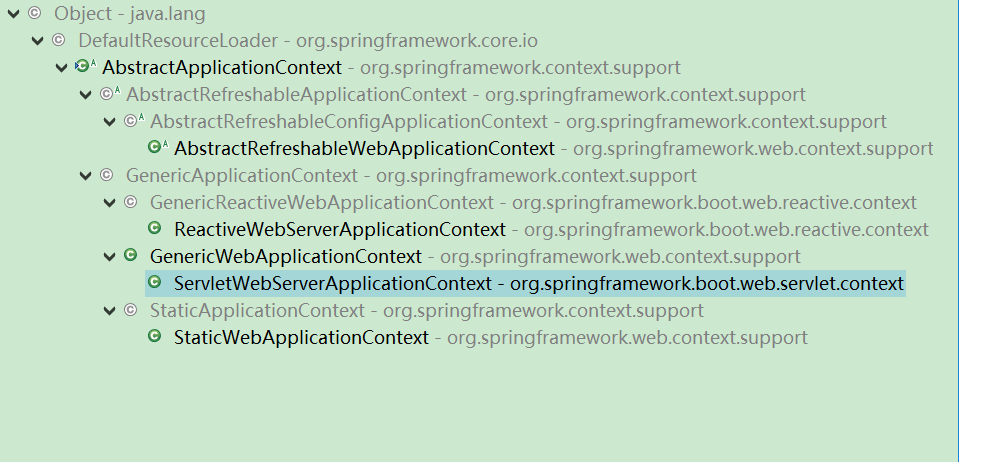
public class ServletWebServerApplicationContext extends GenericWebApplicationContext
implements ConfigurableWebServerApplicationContext { @Override
protected void onRefresh() {
super.onRefresh();
try {
createWebServer();
}
catch (Throwable ex) {
throw new ApplicationContextException("Unable to start web server", ex);
}
} private void createWebServer() {
WebServer webServer = this.webServer;
ServletContext servletContext = getServletContext();
if (webServer == null && servletContext == null) {
ServletWebServerFactory factory = getWebServerFactory();
this.webServer = factory.getWebServer(getSelfInitializer());
}
else if (servletContext != null) {
try {
getSelfInitializer().onStartup(servletContext);
}
catch (ServletException ex) {
throw new ApplicationContextException("Cannot initialize servlet context",
ex);
}
}
initPropertySources();
} }
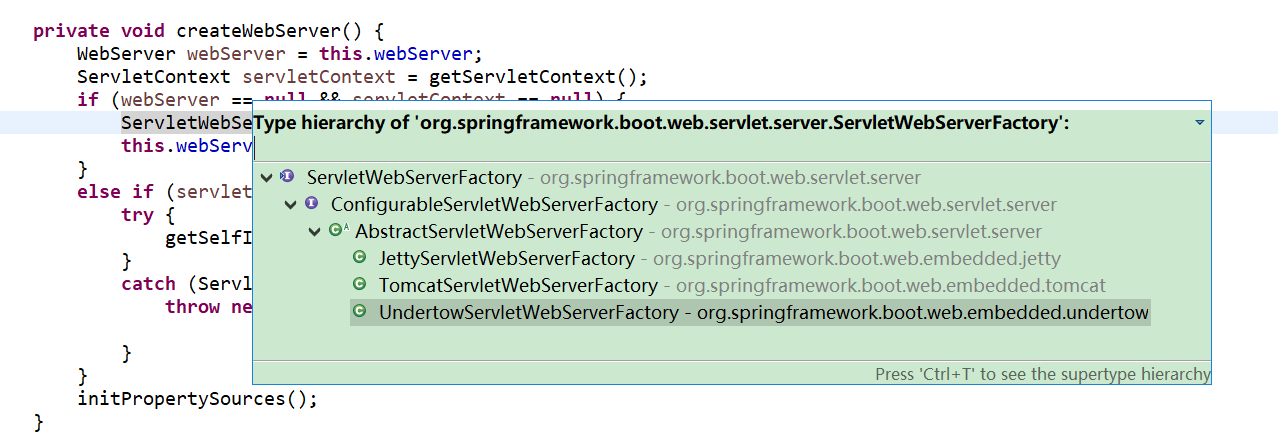
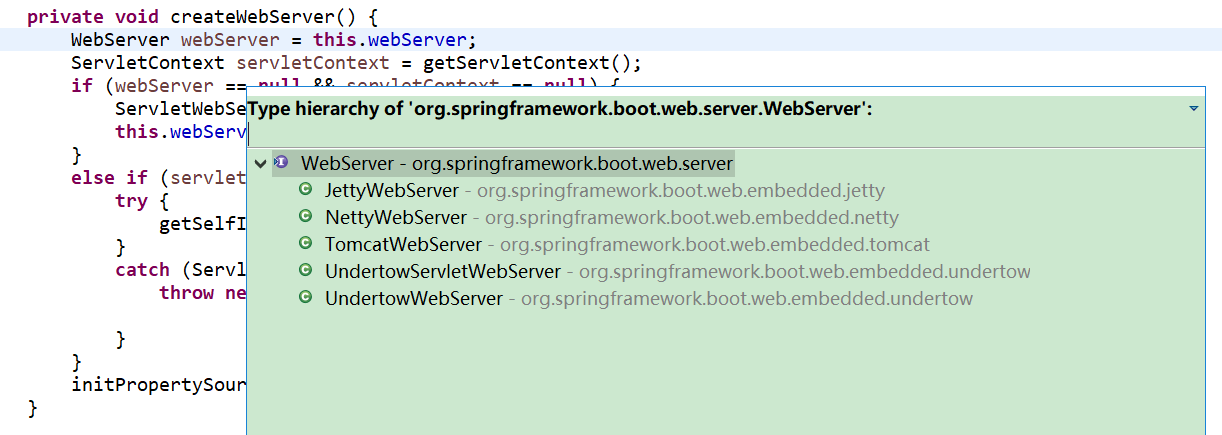
spring-boot-2.1.0.RELEASE.jar
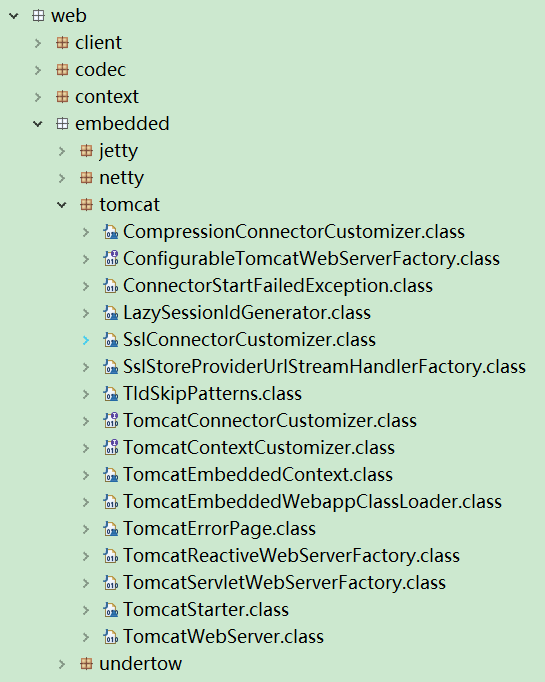
17. Spring Boot 配置嵌入式Servlet容器的更多相关文章
- 【串线篇】spring boot配置嵌入式servlet容器
SpringBoot默认使用Tomcat作为嵌入式的Servlet容器 问题? 一.如何定制和修改Servlet容器的相关配置 1.方法1修改和server有关的配置(ServerProperties ...
- Spring boot 配置嵌入式Servlet容器
SpringBoot默认使用Tomcat作为嵌入式的Servlet容器 1.修改和server有关的配置(ServerProperties[也是EmbeddedServletContainerCust ...
- 17、配置嵌入式servlet容器(1)
SpringBoot默认使用Tomcat作为嵌入式的Servlet容器 1).如何定制和修改Servlet容器的相关配置 1.修改和server有关的配置 (Se ...
- (7)Spring Boot web开发 --- servlet容器
文章目录 配置嵌入式 Servlet 容器 注册 三大组件 使用其他 servlet 容器 使用外置的 `Servlet` 容器 配置嵌入式 Servlet 容器 Spirng Boot 默认使用自带 ...
- 18、配置嵌入式servlet容器(2)
使用其他Servlet容器 -Jetty(长连接) -Undertow(不支持jsp) 替换为其他嵌入式Servlet容器 默认支持: Tomcat(默认使用) Jetty: <depend ...
- SpringBoot配置嵌入式Servlet容器
1).如何定制和修改Servlet容器的相关配置: 1.修改和server有关的配置(ServerProperties[也是EmbeddedServletContainerCustomizer]): ...
- 配置嵌入式Servlet容器
SpringBoot默认是用的是Tomcat作为嵌入式的Servlet容器:问题?1).如何定制和修改Servlet容器的相关配置:1.修改和server有关的配置(ServerProperties) ...
- 19、配置嵌入式servlet容器(下)
使用外置的Servlet 嵌入式Servlet容器:应用打成可执行的j ar 优点:简单.便携: 缺点:默认不支持JSP.优化定制比较复杂 使用定制器[ServerProperti ...
- SpringBoot起飞系列-配置嵌入式Servlet容器(八)
一.前言 springboot中默认使用的是tomcat容器,也叫做嵌入式的servlet容器.因为它和我们平常使用的tomcat容器不一样,这个tomcat直接嵌入到的springboot,平常我们 ...
随机推荐
- BatchNormalization的使用
# import BatchNormalization from keras.layers.normalization import BatchNormalization # instantiate ...
- link & auto cards
link & auto cards a link to card link https://docs.embed.ly/docs/cards DD WX <blockquote clas ...
- 我的Linux系统九阴真经
在今天,互联网的迅猛发展,科技技术也日新月异,各种编程技术也如雨后春笋一样,冒出尖来了.各种创业公司也百花齐放百家争鸣,特别是针对服务行业,新型互联网服务行业,共享经济等概念的公司,越来越多.有一些公 ...
- APICloud之封装webApp
注册用户 https://www.apicloud.com/ 使用步骤 进入开发控制台 创建应用 选择webApp 根据自己的情况填写信息,然后创建即可 应用创建后的界面 端设置 app界面设置 证书 ...
- Assign the task HDU - 3974(dfs序+线段树)
There is a company that has N employees(numbered from 1 to N),every employee in the company has a im ...
- day10 局部变量 全局变量 作用域前奏
规则命名以及基本介绍 name="LHF" # 顶头写的全局都可以调用的就是全局变量,命名规则要求大写全局变量 def chang_name(): # global name # ...
- 【 Gym - 101138D 】Strange Queries (莫队算法)
BUPT2017 wintertraining(15) #4B Gym - 101138D 题意 a数组大小为n.(1 ≤ n ≤ 50 000) (1 ≤ q ≤ 50 000)(1 ≤ ai ≤ ...
- AtCoder Regular Contest 063 F : Snuke’s Coloring 2 (线段树 + 单调栈)
题意 小 \(\mathrm{C}\) 很喜欢二维染色问题,这天他拿来了一个 \(w × h\) 的二维平面 , 初始时均为白色 . 然后他在上面设置了 \(n\) 个关键点 \((X_i , Y_i ...
- 01 Zabbix采集数据方式
Zabbix采集数据方式 1. zabbix采集数据方式: 基于专用agent 被监控的设备上面安装agent软件,这个agent必须在设备上面有采集数据的权限 基于SNMP, net-snmp ...
- 洛谷 P2059 [JLOI2013]卡牌游戏 解题报告
P2059 [JLOI2013]卡牌游戏 题意 有\(n\)个人玩约瑟夫游戏,有\(m\)张卡,每张卡上有一个正整数,每次庄家有放回的抽一张卡,干掉从庄家起顺时针的第\(k\)个人(计算庄家),干掉的 ...
